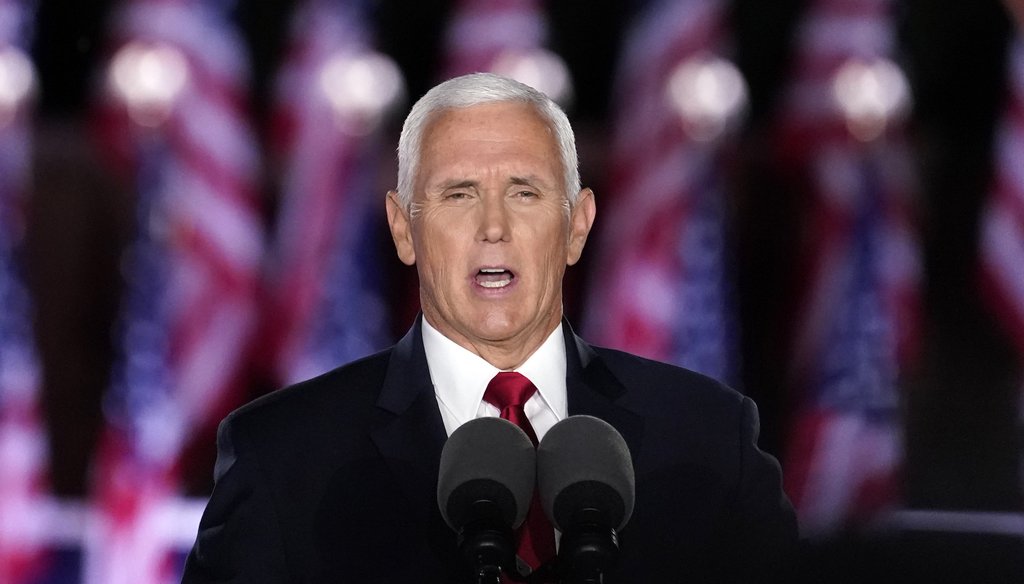

Our only agenda is to publish the truth so you can be an informed participant in democracy.
We need your help.


Vice President Mike Pence speaks on the third day of the Republican National Convention at Fort McHenry National Monument and Historic Shrine in Baltimore, Wednesday, Aug. 26, 2020. (AP Photo/Andrew Harnik)
As former Vice President Mike Pence considers a 2024 presidential run, he’s been making the rounds on television.
In a March 24 interview with Fox Business’ Maria Bartiromo, Pence criticized the nation’s fiscal position.
"We have a national debt the size of our nation’s economy for the first time since World War II," he said. "Joe Biden’s policy is insolvency."
Measured in raw numbers, the nation’s debt is sizable at $31.45 trillion. But experts tend to provide context to the federal debt by comparing it with the size of the economy as a whole.
By one common measure, publicly held debt, it’s currently slightly below 100% of gross domestic product. Using that measure, debt exceeded the GDP in 2020, when Pence was still in office. That was attributable to the COVID-19 pandemic, which led to a series of large emergency rescue packages.
By another common measure, gross federal debt, the debt has been 100% of gross domestic product for the past decade, including Pence’s vice presidency.
Experts consider both federal debt metrics valid.
Publicly held debt, the smaller of the two figures, includes debt held by the general public through Treasury bills, bonds and notes. Some is held by U.S. nationals, and some by foreigners.
The larger figure, gross federal debt, takes the publicly held debt and adds to it the debt that the government owes itself. This typically happens when trust funds, such as those that pay for Social Security and Medicare, accept federal IOUs.
Publicly held debt reached 100% of GDP for the first time since World War II in 2020, the final year of the Trump-Pence administration. Since then, the percentage has fallen below 100%, but not by much; it was 97% in 2022. It’s projected to exceed 100% by the end of 2024. This is the figure Pence’s team pointed us to.
The larger figure, gross federal debt, reached 100% of GDP for the first time in the postwar era in 2013, when Barack Obama was president and Joe Biden was vice president. It remained above 100% for the rest of the Obama-Biden administration and the entire Trump-Pence administration. It remains above 100% during Biden’s presidency.
As with publicly held debt, the gross federal debt as a percentage of GDP peaked in 2020, the first year of the COVID-19 pandemic, at almost 128%. It has fallen by a couple of percentage points under Biden.
Pence has been open about his regrets over the level of federal deficits during his time as vice president.
"I don’t think the Trump-Pence administration did enough to rein in big government spending," Pence told the PBS NewsHour’s Judy Woodruff in December 2022. "Now, in the midst of COVID, we spent what we needed to spend to get American families and American businesses through that worst pandemic in 100 years. But I do believe whoever is the next president, it’ll be important that we bring about the kinds of reforms and we make the kinds of choices necessary to lift the burden of more than $30 trillion in debt on our children and grandchildren."
Having the national debt reach 100% of GDP sounds scary. But economists say it’s not necessarily an ominous sign for a country like the U.S. that has strong credit, big reserve assets and expansive borrowing capacity. Such countries can more easily manage their debt loads and keep their governments functioning over the long term without resorting to tax increases, former International Monetary Fund Chief Economist Olivier Blanchard said in a 2019 speech.
In general, it’s overly simplistic to blame, or credit, any president for changes in the federal debt.
Much of our current level of debt has been driven by mandatory spending on Social Security and Medicare, which have been increasing because of the aging of the baby boom generation. These expenditures have essentially been on autopilot.
For other types of spending, it takes both the president and Congress to enact legislation, and control of the White House and Congress has shifted between the parties in recent years.
Pence said, "We have a national debt the size of our nation’s economy for the first time since World War II."
Pence has a point that today the national debt, depending on what measure is used, is either 100% of GDP or slightly less.
However, today’s debt-to-GDP level is not 100% for the "first time since World War II."
By one commonly used measure, it’s been above 100% since 2013, and by another, it hit 100% in 2020.
The statement is partially accurate but leaves out important details. We rate it Half True.
Mike Pence, interview with Fox Business’ Maria Bartiromo, March 24, 2023
Office of Management and Budget, Table 7.1—Federal Debt at the End of Year: 1940–2028, accessed March 29, 2023
Federal Reserve Bank of St. Louis, "Gross Federal Debt Held by the Public as Percent of Gross Domestic Product," accessed March 29, 2023
Federal Reserve Bank of St. Louis, Gross "Federal Debt as Percent of Gross Domestic Product," accessed March 29, 2023
Mike Pence, interview with Judy Woodruff of the PBS NewsHour, December 2022
New York Times, "Missing From Biden’s Budget: His Plan for Social Security," March 10, 2023
ABC News, "Biden's 2024 budget doesn't include plan to shore up Social Security's finances," March 10, 2023
Associated Press, "AP Explains: US debt will soon exceed size of entire economy," Sept. 5, 2020
PolitiFact, "Did the national debt become bigger than the U.S. economy? Yes, before Biden took office," July 2, 2021
Email interview with Steve Ellis, president of Taxpayers for Common Sense, March 29, 2023
In a world of wild talk and fake news, help us stand up for the facts.
